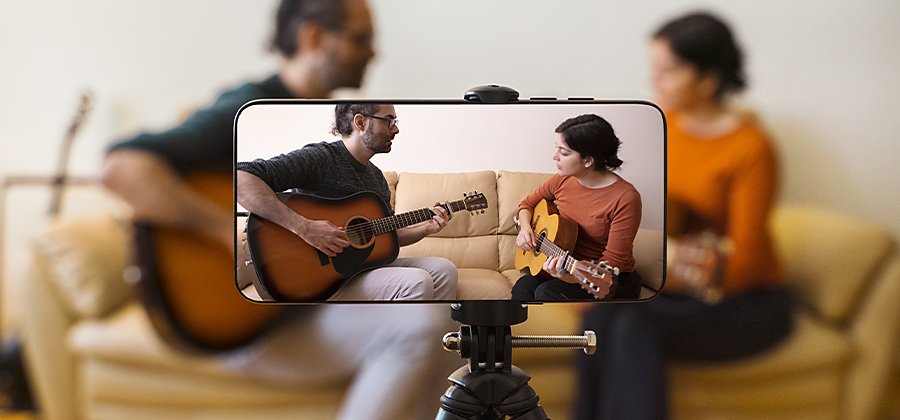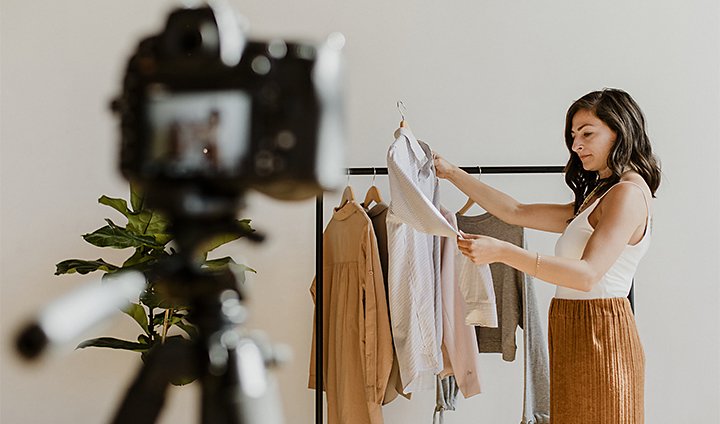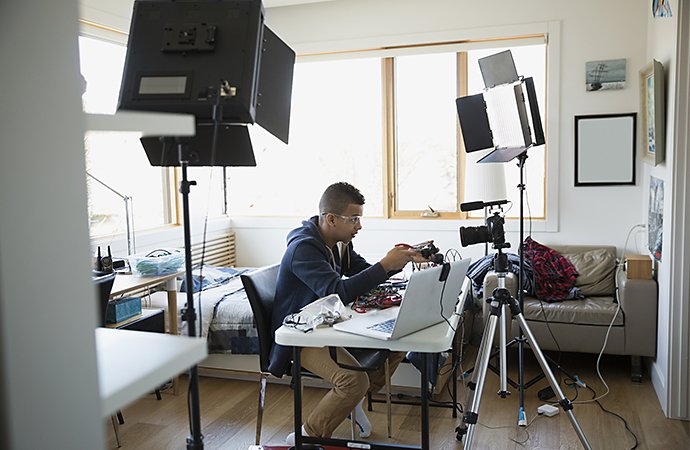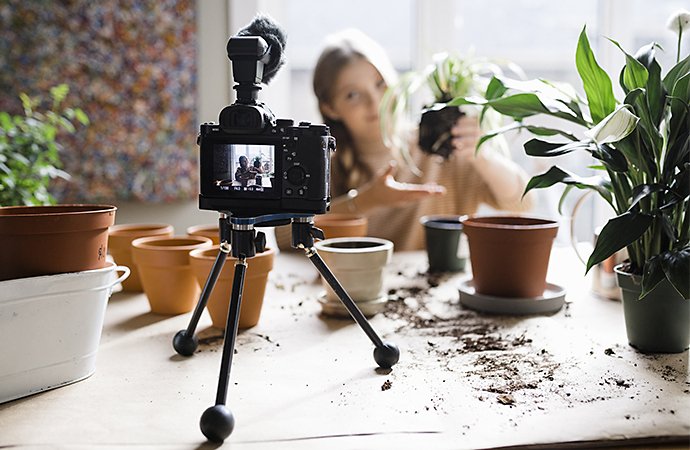How to start and manage your own youtube channel
Learn what you should consider when starting a new YouTube channel and how to grow it into a success, keeping content fresh from your first video to your hundredth.

The biggest TV channel the world has ever known.
YouTube is enormous. The video site is home to everything from music videos and vlogging to news programs and nature footage. Anyone with a camera can create a YouTube account and start a channel. But if you want to start a channel that will help you successfully grow an audience for your work, you’ll need more than just a few videos — even if those videos are the type of content that could take the internet by storm. You’ll need a strategy and the right outlook to maximize what you can get out of the platform.
Standing out from the crowd.
A YouTube channel can be about nearly anything, but successful channels tend to have something in common: the creators are genuinely interested in their topics.

“I truly believe that every successful YouTube channel has a spark of something that is very personal to whoever is creating it,” says YouTuber Daniel Hashimoto. YouTube has no shortage of creators imitating other creators, but it’s not a good formula for long-term success. Copying someone else’s niche won’t take you as far as finding your own. “It’s less important to chase trends and try to mimic something you think will be popular,” says Hashimoto. “It’s more important to dial down to something really important for you personally.”
Originality stands out. Obviously, imitation is something the audience will pick up on. YouTube is big enough to accommodate whatever it is you’re sincerely enthusiastic about, so focus on that. It will make your content better and draw more genuine traffic to your channel.
Producing, recording, and sharing videos.
Video creation takes time. It’s not enough to simply set up a camera, start recording, and put the unedited results online. Getting good at this process takes practice. “My best advice is to just start making videos,” says YouTuber John Spannos. “The first 10 videos you make are going to be bad. Don’t even upload them. Just make videos to get used to the process.”
YouTube production quality varies. Videos are shot on everything from high-quality cameras to old smartphones. Investing in cameras, building a set, using a green screen, and learning how to edit videos can all be important factors for successful YouTube video series. However, when it comes to retaining an audience’s attention, visuals aren’t necessarily the most critical element. “Audio, in my opinion, is the most important part of the video,” says Spannos. “I think people can forgive not-so-great video quality, but if the video has bad audio, they’ll click away. Invest in a microphone.” Even vloggers who are just talking to the camera in front of a wall make sure they don’t have echoes or audio feedback. Pay attention to sound if you want an audience to pay attention to you.


After you’ve recorded and edited your YouTube videos, you also need to make sure they’re properly tagged and labeled with effective thumbnails. Thumbnails are the small preview images the user will see as they scroll through search results. Video titles and thumbnails are extraordinarily important. They can help your video grab viewer attention and earn a click. Creating effective thumbnails means splitting the difference between accurate labels and enticing a click.
“You have to find a balance between telling people what the video is about and clickbaiting them,” says Spannos. Your channel name, channel art, channel description, cover photo, and thumbnails all have to be honest. You have to be forthright and transparent with your target audience. But, you still want to maintain something of a mystique that will drive engagement. It’s a fine balance, and one that creators and vloggers gradually adjust as they make more YouTube content.
Creating content, keeping up, and audience retention.
Successful YouTubers keep a regular production and video publishing schedule. “The algorithm likes consistency,” says Spannos. “My audience expects once a week. I think that’s what the YouTube audience as a whole expects.” That means the search function on YouTube will be a bit more favorable to channels that upload videos with regularity.

- Staying on schedule.
Regular production can help establish your voice on the platform and allow you to stand out in a crowded field. “Nowadays on YouTube, you’re competing with huge people who already have loud voices,” says Hashimoto. “I definitely recommend trying to post something regularly. Come up with a schedule of production that makes sense for you.”
Keeping a consistent schedule and producing good content can sometimes be at odds with each other. Topical videos tend to do very well, but staying on top of a schedule and staying on top of the news can pull a YouTuber in different directions. “People want videos about what’s happening right now,” says Spannos. “I can’t plan three weeks in advance.” If you do have a channel that engages with current events, build in evergreen content that’s compelling regardless of the news cycle and you can publish it anytime you need to fill gaps.
Long, ambitious projects can be hard to fit into a weekly publication schedule. “If you’re working on a project that’s going to take a long time, it’s better to share it in pieces,” says Hashimoto. It is possible to do long-form work on YouTube, and some successful videos are well over an hour or even two hours long. However, in order to stay engaged with your audience, give them some other new content while you’re working on longer videos. Break your longer content into teasers and updates, more digestible videos that you can post during your regular schedule, to keep people up to date on your progress and build excitement.
Creating content for an algorithm and search engine will take you only so far. Ultimately, you have to make YouTube videos for people. “If your goal is sharing your work with a large audience,” says Hashimoto, “you have to consider that large audience as part of your process.” Your most engaged audience members can be your most important champions. If they like your videos, they’ll share them on different social networks and draw more people in, growing your target audience. YouTube SEO (search engine optimization) is always changing and it can pay to stay on top of those technical details, but ultimately it’s good, shareable content that’s going to take you farther.


This is also true when it comes to engaging with other YouTubers. If there are content creators or influencers you admire, consider reaching out to them to collaborate on a project. Collaborations are generally mutually beneficial, and you’ll be able to delight two separate audiences with your work.
Engagement doesn’t just mean communicating with your audience. Prospective YouTubers have to be ready for the negativity and backlash that comes with reaching a wide audience. “I know a lot of people aren’t prepared for the negativity that comes along with it,” says Spannos. “You do get a lot of negative comments on YouTube.”
Have a strategy for how you’ll deal with negative comments and harassment. Some people respond with humor. “I think they’re funny,” says Spannos, “I make videos out of my mean comments.” You can also try to ignore the trolls, but another strategy is having someone else vet your comments or deal with all the inevitable insults, scouting ahead and flagging the trolls so you don’t have to.
What success on YouTube looks like.
If your channel is popular enough, some brands might ask for you to put sponsored content at the start or end of your videos. “Know how to interact with larger companies,” says Hashimoto. Branding opportunities can be lucrative for YouTubers, but you have to know how to advocate for yourself and what to say yes to in order to get a good deal. Success on YouTube also comes in the form of ad revenue and a platform to promote your other projects. If you have something you want to promote, like a product, book, or podcast, YouTube can be an excellent way to get the word out.


Whatever you want to say, there’s nothing stopping you from adding your voice to the YouTube community. With planning, consistency, and a properly set up and well-managed channel page, you can help your voice rise above the din, allowing you to grow an audience for your video work.
Contributors
Do more with Adobe Premiere Pro.
Create and edit video from anywhere—phone, tablet, and desktop. Edit and share for social your professional-looking videos.
You might also be interested in…
Learn the basics to help you break into this popular audio medium.
Take your music video from concept to post-production with these tips from veteran filmmakers.
Edit videos on your phone.
Use Adobe Premiere Rush to edit video clips and merge them into one video file for web or social.
What ASMR is and how to build a YouTube following.
Millions turn to ASMR to help them relax. Learn how to create a video that calms and comforts.



